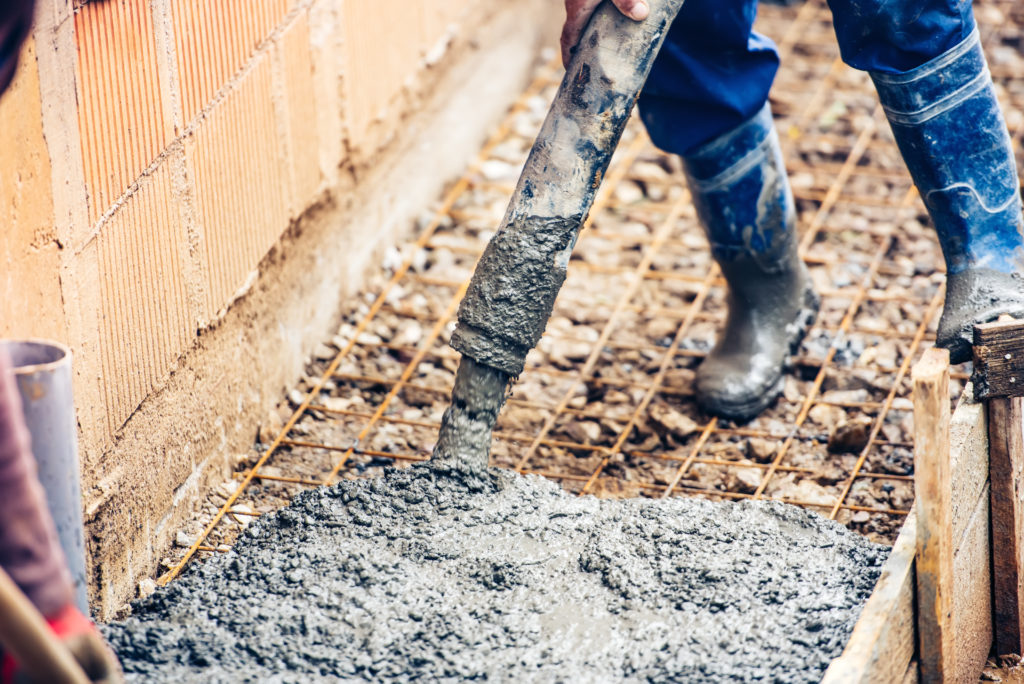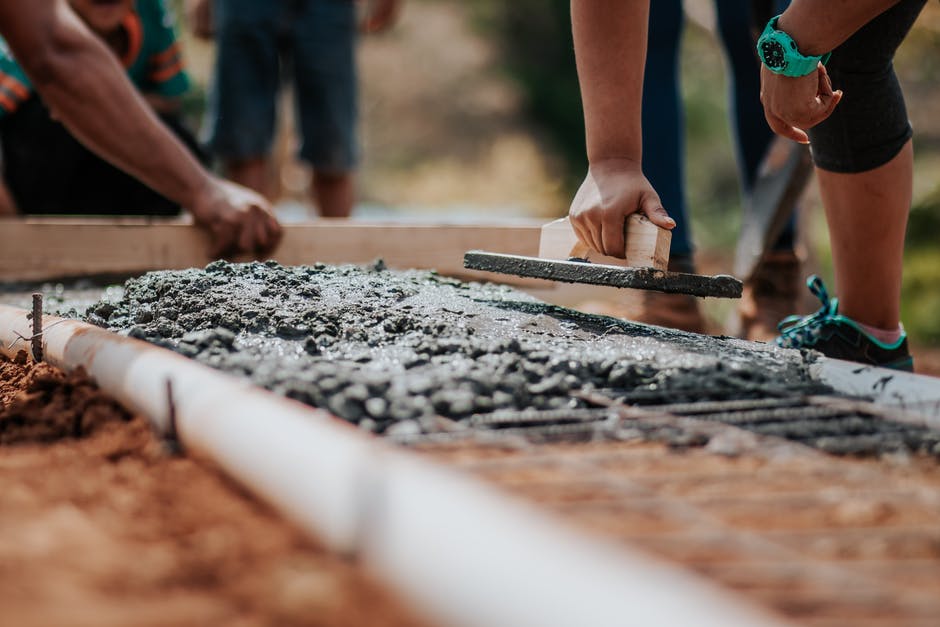
It’s a concrete jungle out there. Concrete is the world’s most used building material with an annual global production of 5 billion cubic yards. Building with concrete is a science as much as it is an art so don’t underestimate the importance of mixing high-quality concrete.
Do you have a building project coming up in Sacramento, California? Chances are you will need ready mix concrete delivery. Concrete can be mixed by hand or a mixing machine on-site, but be sure to do it right or risk significantly reducing the structure’s integrity.
Before you start building, learn what you can about concrete, how it is mixed, and best practices for building with concrete.
Once building is complete, landscapers reclaim the building site. We will touch on this often neglected final step here as well as answer the most asked questions concerning concrete construction projects. Keep reading to set your mind towards professional concrete and landscaping work.
How to Properly Mix Concrete?
The strength and longevity of the concrete you mix is determined by the materials used and in what ratio they are mixed. Think of mixing concrete like mixing batter for a cake, the ingredients must be mixed in the proper amounts or the cake won’t come out tasting as you hoped. The three main components of concrete are:
- Cement
- Aggregates
- Water
Isn’t cement and concrete the same thing? Actually, no. Although the terms cement and concrete are often used interchangeably, cement is actually the binding agent in concrete. Cement is used by itself for some purposes such as grouting.
In order to strengthen the concrete and prevent cracking aggregates are mixed in with the cement. Various types of sand and gravel are used as the aggregate in concrete. A typical self-mixing concrete job is done by mixing bags of cement with bags of sand and then washed gravel thrown in.
The 1-2-3 Concrete Ratio
Often referred to as the classic concrete building ratio, the 1-2-3 ratio is the most versatile of mix ratios. It can be used at most any scale or size of project.
When mixing batches of concrete on the building site, special care to get the ratio just right is all-important. Many contractors use 5-gallon buckets to achieve this. Each 5-gallon bucket is a “part” of the mix.
The classic concrete ratio is one part cement powder, two parts sand, and three parts washed aggregate or gravel. In other words to mix a batch of this concrete by hand workers would mix together 1 bucket of cement, 2 buckets of sand, and 3 buckets of washed aggregate.
The final step is “just add water.” The amount of water needed to pour concrete can vary depending on weather conditions, amount of moisture present in the aggregate, and other factors. A good rule of thumb to follow is 25 gallons of water for every 100 gallons of concrete or a 1/4 ratio. So, for the 5-gallon bucket batch of 1-2-3 concrete mix ratio, you would add about 1.2 buckets of water.
What Happens if More Water Is Added to Concrete?
Mixing concrete with the right amount of water is important for several reasons. Use too little and the concrete will not pour well or at all. Too much water will affect strength, water tightness, weathering durability, and the potential for cracking.
The more water used the more the concrete will shrink as it sets. Estimating the degree of shrinking is an important consideration when building the right-sized concrete forms. Concrete slabs, foundations, pavement, and patios settle lower as the concrete drys so this needs to be taken into account when pouring.
You need enough water for workability, but not too much as to keep from weakening the integrity of the final product. Consult with a concrete professional when in doubt.
High-Pressure Concrete Mix Ratios
The classic ratio above is appropriate for most projects. If a high tensile strength of concrete is needed for the build it is highly recommended to use factory grade ready mixed concrete to ensure the best quality.
Mixtures rated at 5,000 psi or more can be achieved by adding certain chemicals to a 1-2-1 concrete mix ratio. Again, heavyweight bearing concrete is tricky to mix properly and best left to the professionals at a concrete factory.
In order to determine the estimated amount of materials you will need for your concrete project, use a concrete calculator.

Advantages of Ready Mix Concrete
Ready mix concrete (RMC) is concrete manufactured in a cement factory according to strict standards, loaded into a mixing truck, and transported to the build site. Although ready mix concrete is more expensive than mixing it yourself it comes with significant advantages such as:
- Large volumes of mixed concrete poured at one time
- High quality of materials mixed to exact ratios
- Reduced labor costs
Cement factories are uniquely equipped with onsite laboratories. The quality of the materials used in ready mixed concrete is, therefore, better controlled.
Another great advantage of having your concrete ready mixed – changing the color with increte concrete systems. Do you want your concrete to better blend into the surrounding environment? With over 900 different color combinations to choose from it is worth giving some thought to adding a unique touch to your project.
Ready mixed concrete must be poured within a certain time window. Some sites are simply too far away from the nearest concrete factory to be feasible that the concrete can be kept from setting too much before it arrives. In this case, contractors have no choice but to mix the concrete on site.
How Long Does it Take for Quikrete Cement to Dry?
A well-known name brand of concrete mix, Quikrete, is the go-to solution for small DIY projects around your home or business. A common question we get is how quickly does it dry?
This depends on the type of Quikrete you use. Most people don’t realize that concrete drys over weeks even months before it is completely set. However, you don’t have to wait a month before it is set enough to walk on or use.
Quikrete 5000 Concrete Mix is the strongest concrete in the product line (rated at 5000psi). This concrete will set to 1,500 psi within 24 hours, but doesn’t reach full strength for about a month.
For the fastest setting concrete, ideal for post setting, use Quikrete Fast-Setting Concrete. This famously fast-setting concrete will cure in about 20 minutes.
What Is the Best Concrete Mix for Roofing?
Steel reinforced concrete slab roofs are a long-lasting roofing solution. Although there is some debate on the best concrete mixing ratio for concrete slab roofs, most professionals agree that 1 part cement, 1.5 part sand, and 3 parts aggregate is a good ratio for concrete slabs, support beams, and columns.
What Results in a Harsh Concrete Mix?
The term “harsh concrete” refers to surface smoothness. Concrete that doesn’t smooth well regardless of troweling is the result of a harsh concrete mix. This can occur because of using low-quality or contaminated cement or dirty gravel but is usually caused by improper mixing ratios.
If the concrete is mixed with too much aggregate, there is not enough cement to fill the gaps resulting in pores and air pockets. Not using enough water can also cause a harsh concrete mix.
How Much Does Concrete Cost?
The cost of concrete depends on several factors including the strength rating, materials used, and whether or not it is ready mixed delivered. Give us a call to learn about our current pricing per yard.
The planning stage includes estimating the cost of the project. When calculating the cost you will need to factor in:
- Local cost of concrete material or ready mix concrete
- The amount of concrete needed to complete the project
- Grading and preparing the site
- Preparing the subbase
- Building and installing concrete forms
- Reinforcements used if needed
- The labor cost involved in pumping, powering, and finishing
- The psi rating of the concrete
The cost of delivering ready mix concrete can increase depending on if you order on the weekend or if the job site is farther away. In some cases, the concrete needs to be poured in an enclosed difficult-to-reach area. If the concrete truck is unable to park directly next to the site, hoses and pumps will be needed and add to the cost of the project.
Landscaping: the Final Touch
By the time a concrete building project is completed, the land around the worksite will undoubtedly be scared with pits and hills. Building and landscaping go hand and hand. You need to remember that when planning a building project. Work it into your budget or quotes if you are a full-service contractor.
Concrete Block Retaining Walls
Working the land around a building often means building structures to hold the ground in the desired areas. A hill can be turned into a multi-level flat area for planting flowers, vegetables, and fruits. Driveways and basement walkways are often set into the land with retaining walls on either side.
Interlocking concrete blocks are the perfect solution to the landscaping needs of tiling and leveling land.
Walkways and Rock Beds
Where the landscape meets the structure is an important focal point in bringing the property together. Consider blending the structure into the surrounding environment by building rock beds along the outside of the building. Planters can easily be placed on top to bring green to the face of the building.
Rock beds and walkways have the advantage of being fire and wind-resistant. Mulching with rocks is a low-maintenance and relatively cheap way to easily maintain excellent curb appeal.
Concrete Patios
The value of a property comes from its practical use such as the square footage of the building. However, how the land around the property is designed can greatly increase its desirability and value. A place to sit and enjoy the outdoors, have a BBQ, and escape the confines of the building for a while can be made by pouring a concrete slab patio.
Make It Green: Flower Beds and Gardens
The wonderful art of landscaping is all about bringing more natural beauty to your property. This is best accomplished by carving out places for planting shrubs, bushes, flowers, etc. All one needs to do is create areas of the property raised off the ground and fill those areas with high-quality top soil and multch.
Sandboxes and Playground Area
Do you have children and want to provide them a safe place to play? A couple of truckloads of sand will do the trick. Installing swings and other playground equipment over sandpits provides a vegetation-free and soft area for the little ones to play.
To calculate the amount of material needed for your landscaping project, use our landscaping calculators.
Landscaping Materials and Ready Mix Concrete Delivery
No matter the size and type of concrete building project you are facing one thing is for sure – the materials you use will ultimately decide its degree of success. Professional contractors to the weekend do-it-yourselfers are all held to the same standards when it comes to the science of concrete.
Ready mix concrete delivery can knock off time to complete construction as well as ensure proper mix ratios. Landscaping is the icing on the cake. Building a concrete structure that blends in with nature is key to the overall experience the property delivers.
Ready to turn those building plans into reality? We have the products you need at competitive prices.





